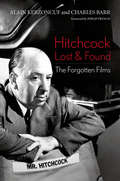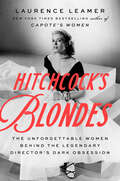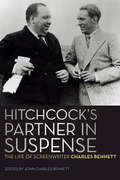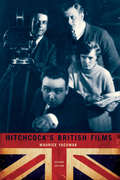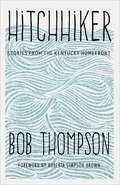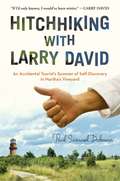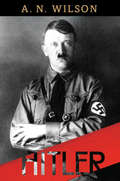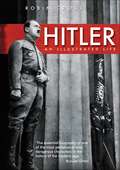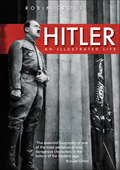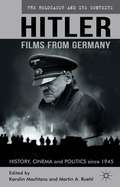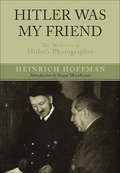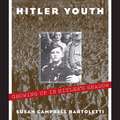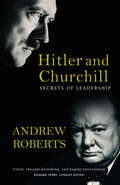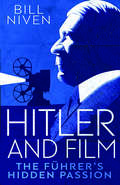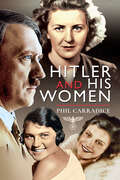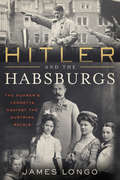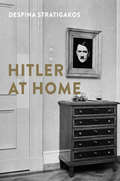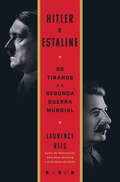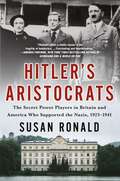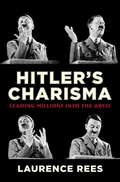- Table View
- List View
Hitchcock Lost & Found: The Forgotten Films (Screen Classics)
by Charles Barr Alain Kerzoncuf&“It seems there is still plenty to discover and to say about Alfred Hitchcock . . . a host of impressive new research.&” —Journal of Film Preservation Audiences worldwide know him for Psycho, The Birds, Vertigo, and other classics—but in Hitchcock Lost and Found, fans and film students alike can explore forgotten, incomplete, lost, and recovered productions from all stages of Alfred Hitchcock&’s career, including his early years in Britain. Alain Kerzoncuf and Charles Barr highlight Hitchcock&’s neglected works, including various films and television productions that supplement the critical attention already conferred on his feature films. They also explore the director&’s career during World War II, when he continued making high-profile features while also committing himself to a number of short war-effort projects on both sides of the Atlantic. Focusing on a range of forgotten but fascinating projects spanning five decades, Hitchcock Lost and Found offers a new, fuller perspective on the incomparable filmmaker&’s career and achievements. &“For the Hitchcock completist, Hitchcock Lost and Found is an essential resource.&” —Philadelphia Inquirer Includes photos and illustrations
Hitchcock's Blondes: The Unforgettable Women Behind the Legendary Director's Dark Obsession
by Laurence LeamerBestselling author of Capote&’s Women Laurence Leamer shares an engrossing account of the enigmatic director Alfred Hitchcock that finally puts the dazzling actresses he cast in his legendary movies at the center of the story.Alfred Hitchcock was fixated—not just on the dark, twisty stories that became his hallmark, but also by the blond actresses who starred in many of his iconic movies. The director of North by Northwest, Rear Window, and other classic films didn&’t much care if they wore wigs, got their hair coloring out of a bottle, or were the rarest human specimen—a natural blonde—as long as they shone with a golden veneer on camera. The lengths he went to in order to showcase (and often manipulate) these women would become the stuff of movie legend. But the women themselves have rarely been at the center of the story, until now.In Hitchcock&’s Blondes, bestselling biographer Laurence Leamer offers an intimate journey into the lives of eight legendary actresses whose stories helped chart the course of the troubled, talented director&’s career—from his early days in the British film industry, to his triumphant American debut, to his Hollywood heyday and beyond. Through the stories of June Howard-Tripp, Madeleine Carroll, Ingrid Bergman, Grace Kelly, Janet Leigh, Kim Novak, Eva Marie Saint, and Tippi Hedren—who starred in fourteen of Hitchcock&’s most notable films and who bore the brunt of his fondness and sometimes fixation—we can finally start to see the enigmatic man himself. After all, &“his&” blondes (as he thought of them) knew the truths of his art, his obsessions and desires, as well as anyone.From the acclaimed author of Capote&’s Women comes an intimate, revealing, and thoroughly modern look at both the enduring art created by a man obsessed…and the private toll that fixation took on the women in his orbit.
Hitchcock's Partner in Suspense: The Life of Screenwriter Charles Bennett (Screen Classics)
by Charles BennettThe colorful life and creative career of the writer behind six of Hitchcock&’s thrillers: &“An intriguing and revealing story.&” —Times Literary Supplement With a career that spanned from the silent era to the 1990s, British screenwriter Charles Bennett lived an extraordinary life. His experiences as an actor, director, playwright, film and television writer, and novelist in both England and Hollywood left him with many amusing anecdotes, opinions about his craft, and impressions of the many famous people he knew. Among other things, Bennett was a decorated WWI hero, an eminent Shakespearean actor, and an Allied spy and propagandist during WWII, but he is best remembered for his commercially and critically acclaimed collaborations with directors Sir Alfred Hitchcock and Cecil B. DeMille. The fruitful partnership with Hitchcock began after the director adapted Bennett&’s 1929 play Blackmail as the first British sound film. Their partnership produced six thrillers: The Man Who Knew Too Much, The 39 Steps, Sabotage, Secret Agent, Young and Innocent, and Foreign Correspondent. In this witty and intriguing book, Bennett discusses how their collaboration created such famous motifs as the &“wrong man accused&” device and the MacGuffin. He also takes readers behind the scenes with the Master of Suspense, offering his thoughts on the director&’s work, sense of humor, and personal life. Featuring an introduction and additional biographical material from Bennett&’s son, editor John Charles Bennett, Hitchcock&’s Partner in Suspense is a richly detailed narrative of a remarkable yet often-overlooked figure in film history.
Hitchcock’s British Films: Second Edition (Contemporary Approaches To Film And Media Ser.)
by Maurice YacowarA reissued classic that examines the structure and themes of each of Hitchcock's British feature films.
Hitchhiker: Stories from the Kentucky Homefront
by Bob ThompsonIn this unique memoir, the adventuresome author combines stories of rural Kentucky and restless travel with tall tales of other worlds and bygone eras. Bob Thompson discovered his passion for storytelling on the front porch of his Granny's country store in McCracken County, Kentucky. Absorbing the tales and traditions he learned there, he kept them close as he went out in search of stories and life experiences of his own. In Hitchhiker, Thompson offers readers homegrown tales that interweave ghosts of the past with real and imagined worlds far beyond his grandmother&’s porch. The stories progress from Bob&’s Tom Sawyer-esque childhood in Western Kentucky through his restless wanderings as a hitchhiking hippie to his adulthood as an unrepentant adventurer following the footsteps of Hemingway and the Lost Generation across Europe. This collection brings together coming-of-age tales, family stories of bygone eras, and even true accounts of unsolved murders and mysteries. Hitchhiker is Huckleberry Finn meets The Twilight Zone, with just a taste of The Electric Kool-Aid Acid Test.
Hitchhiking with Larry David
by Paul Samuel DolmanA memoir about a broken-hearted, middle-aged man who stumbles upon solace, meaning, and Larry David while hitchhiking his way around Martha's Vineyard One summer day on Martha's Vineyard Paul Samuel Dolman was hitchhiking, and none other than Larry David pulled over and asked, "You're not a serial killer or something, are you?" The comedic writer and actor from Seinfeld and Curb Your Enthusiasm not only gave Dolman a ride, but helped him find his way during his summer of soul-searching and hitchhiking. Dolman found himself on Martha's Vineyard that summer having made the catastrophic mistake of visiting "The Parental Asylum" in the wake of a painful breakup. His mother is welcoming, albeit senile and neurotically rigid. But his dad "only has the social energy to be nice to humans for about 10 minutes a day." Desperately seeking companionship, Dolman begins hitchhiking around the island and meets a wide array of characters: the super-rich and the homeless, movie stars and common folk, and, of course, Mr. David. Astonishingly, it is Dolman's growing friendship with the famous comedian that becomes the lodestar of his spiritual quest. (Yes, Larry David gets deep!) Written with disarming honest humor and perfectly capturing Larry David's unique comic genius, Hitchhiking with Larry David will leave readers simultaneously laughing and crying as they ponder the mystery and spirituality of life.
Hitler
by A. N. WilsonA ruthless dictator who saved his country from economic ruin only to nearly destroy it#151;and an entire people#151;in his quest for world domination, Adolf Hitler forever changed the course of history. In this masterful account of Hitler’s life, biographer A. N. Wilson pulls back the curtain to reveal the man behind the mythic figure, shedding new light on Hitler’s personality, his desires, and his complex relationship with the German people. While Hitler maintained that his life had been characterized by #147;struggle” from its very beginnings, Wilson shows that the reality could not have been more different. Hitler grew up in middle-class comfort and, as a young man, lacked ambitions of any sort besides a vaguely bohemian desire to become an artist. And while the Hitlerian mythos holds that he forged his skills as a leader during the First World War, Wilson explains the truth: Hitler spent most of the war as an office boy miles from the front lines, and only received his cherished Iron Cross because of his slavishness to the officers he served. The army gave him a sense of purpose and brotherhood, however, which continued to inspire Hitler once the war ended. Hitler left the army with no skills, contacts, or money#151;and yet, within fourteen years, he would become chancellor of the German nation. Wilson describes the story of Hitler’s ascent as one of both opportunism and sheer political shrewdness. He possessed no real understanding of the workings of government but had a prodigious knack for public speaking, and found that a large number of Germans, despairing at their country’s recent defeat and terrified by the specter of international communism, were willing to listen to the right-wing fantasies that had taken root inside his head. Allying himself with the extremist German Workers’ Party (soon renamed the National Socialist Party), Hitler offered many Germans a seductive vision of how the country might raise itself back up and reclaim its rightful place at the center of world politics. Wilson shows that, although Hitler’s bid for power stalled at first, he soon gained traction with a German public starved for hope. Using his skills as a manipulator, Hitler found himself first at the head of the Nazi Party, then at the helm of the German nation. Wilson explores the forces that allowed Hitler to become Chancellor of Germany, and later to march Germany into total war. He examines Hitler’s increasingly virulent anti-Semitism and his decision to implement the Final Solution to exterminate European Jews, and he considers Hitler’s tactical successes#151;and failures#151;in World War II. Wilson also reveals a great deal about how Hitler’s personal life affected his time as Germany’s leader, from the lasting pain caused by the death of his mother and the suicide of his young niece to his poor health and addiction to the drugs prescribed by his doctor. As Wilson demonstrates, Hitler the Führer was not so different from Hitler the bohemian: lazy, moody, and hypersensitive, he ruled more through intimidation and the mystifying force of his personality than through any managerial skill or informed decision-making. His story#151;and that of Germany#151;is ultimately a cautionary tale. In a modern era enamored with progress, rationality, and modernity, it is often the darkest and most chaotic elements of society that prove the most seductive. Hitler’s unlikely rise to power and his uncanny ability to manipulate his fellow man resulted in the deaths of millions of Europeans and a horrific world war, yet despite his colossal role in world history, he remains mythologized and, as a result, misunderstood. In Hitler, A. N. Wilson limns this mysterious figure with great verve and acuity, showing that it was Hitler’s frightening normalcy#151;not some otherworldly evilness#151;that makes him so truly terrifying.
Hitler
by Robin CrossAs Chancellor of Germany between 1933 and 1945, Adolf Hitler exercised unrestricted power over his country's social, political, and economic life. From Hitler's belligerent re-armament programme to his imposition of anti-Semitic legislation and territorially aggressive policies, respected historian Robin Cross maps out the life of one of the most evil men ever to have lived. This succinct and powerful account, illustrated with rare and chillingly evocative photographs, is the essential companion for anyone with a fascination for the twentieth century, the Second World War or the age of dictators.
Hitler
by Robin CrossAs Chancellor of Germany between 1933 and 1945, Adolf Hitler exercised unrestricted power over his country's social, political and economic life. Hitler's belligerent re-armament programme, his imposition of anti-Semitic legislation and his territorially aggressive policies led to genocide and worldwide conflict on an unprecedented scale. Although the subject of numerous biographies and fictional portrayals, there have hitherto been few succinct, factual narratives of Hitler's life. Hitler is a short chronicle of the Fuhrer's career, amplified with numerous rare photographs and artefacts from the period. Second World War expert Robin Cross offers a clear outline of Hitler's progress: from his unhappy childhood as the son of a minor Austrian official in Braunau, to his inglorious early occupation as a jobbing Viennese artist; from his formative experiences as a corporal in the First World War, to his emergence as leader of the National Socialist Workers' Party in the 1920s; from his extraordinary rise to supreme power in 1933, to his suicide amidst the ruins of Berlin in 1945. Commanding, informative and stylish, and written by a scholar who is steeped in knowledge of the period, Hitler is an essential companion for anyone with a fascination for the twentieth century, the Second World War or the age of dictators.
Hitler
by Robin CrossAs Chancellor of Germany between 1933 and 1945, Adolf Hitler exercised unrestricted power over his country's social, political and economic life. Hitler's belligerent re-armament programme, his imposition of anti-Semitic legislation and his territorially aggressive policies led to genocide and worldwide conflict on an unprecedented scale. Although the subject of numerous biographies and fictional portrayals, there have hitherto been few succinct, factual narratives of Hitler's life. Hitler is a short chronicle of the Fuhrer's career, amplified with numerous rare photographs and artefacts from the period. Second World War expert Robin Cross offers a clear outline of Hitler's progress: from his unhappy childhood as the son of a minor Austrian official in Braunau, to his inglorious early occupation as a jobbing Viennese artist; from his formative experiences as a corporal in the First World War, to his emergence as leader of the National Socialist Workers' Party in the 1920s; from his extraordinary rise to supreme power in 1933, to his suicide amidst the ruins of Berlin in 1945. Commanding, informative and stylish, and written by a scholar who is steeped in knowledge of the period, Hitler is an essential companion for anyone with a fascination for the twentieth century, the Second World War or the age of dictators.
Hitler - Films from Germany
by Martin A. Ruehl Karolin MachtansThe first book-length study to critically examine the recent wave of Hitler biopics in German cinema and television. A group of international experts discuss films like Downfall in the context of earlier portrayals of Hitler and draw out their implications for the changing place of the Third Reich in the national historical imagination.
Hitler Was My Friend: The Memoirs of Hitler’s Photographer
by Heinrich HoffmannHeinrich Hoffman was a key part in the making of the Hitler legend, the photographer who carefully crafted the image of the Fhrer as a godlike figure. Hoffmann published his first book of photographs in 1919, following his work as an official photographer for the German army. In 1920 he joined the Nazi Party, and his association with Hitler began. He became Hitler's official photographer and traveled with him extensively. He took over two million photographs of Hitler, and they were distributed widely, including on postage stamps, an enterprise that proved very profitable for both men. Hoffmann published several books on Hitler in the 1930s, including The Hitler Nobody Knows (1933). Hoffmann and Hitler were very close, and he acted not only as a personal confidante—his memoirs include rare details of the Fhrer—but also as a matchmaker it is Hoffmann who introduced Eva Braun, his studio assistant, to Hitler.At the end of the war, Hoffmann was arrested by the US military, who also seized his photographic archive, and was sentenced to imprisonment for Nazi profiteering. This edition of a classic book includes photographs by Hoffmann and a new introduction by Roger Moorhouse.
Hitler Youth: Growing Up in Hitler's Shadow
by Susan Campbell BartolettiIn her first full-length nonfiction title since winning the Robert F. Sibert Award, Susan Campbell Bartoletti explores the riveting and often chilling story of Germany's powerful Hitler Youth groups.<P><P> "I begin with the young. We older ones are used up... But my magnificent youngsters! Look at these men and boys! What material! With them, I can create a new world." --Adolf Hitler, Nuremberg 1933<P> By the time Hitler became Chancellor of Germany in 1933, 3.5 million children belonged to the Hitler Youth. It would become the largest youth group in history. Susan Campbell Bartoletti explores how Hitler gained the loyalty, trust, and passion of so many of Germany's young people. Her research includes telling interviews with surviving Hitler Youth members.<P> Newbery Medal Honor book and Sibert Honor book
Hitler and Churchill: Secrets of Leadership
by Andrew Roberts'His book is timely and a triumph. Roberts manages to convey all the reader needs to know about two men to whom battalions of biographies have been devoted' EVENING STANDARDAdolf Hitler and Winston Churchill were two totally opposite leaders - both in what they stood for and in the way in which they seemed to lead. Award-winning historian Andrew Roberts examines their different styles of leadership and draws parallels with rulers from other eras. He also looks at the way Hitler and Churchill estimated each other as leaders, and how it affected the outcome of the war. In a world that is as dependent on leadership as any earlier age, HITLER AND CHURCHILL asks searching questions about our need to be led. In doing so, Andrew Roberts forces us to re-examine the way that we look at those who take decisions for us.
Hitler and Film: The Führer's Hidden Passion
by Bill NivenAn exposé of Hitler’s relationship with film and his influence on the film industry A presence in Third Reich cinema, Adolf Hitler also personally financed, ordered, and censored films and newsreels and engaged in complex relationships with their stars and directors. Here, Bill Niven offers a powerful argument for reconsidering Hitler’s fascination with film as a means to further the Nazi agenda. In this first English-language work to fully explore Hitler’s influence on and relationship with film in Nazi Germany, the author calls on a broad array of archival sources. Arguing that Hitler was as central to the Nazi film industry as Goebbels, Niven also explores Hitler’s representation in Third Reich cinema, personally and through films focusing on historical figures with whom he was associated, and how Hitler’s vision for the medium went far beyond “straight propaganda.” He aimed to raise documentary film to a powerful art form rivaling architecture in its ability to reach the masses.
Hitler and Stalin: Parallel Lives
by Alan BullockForty years after his Hitler: A Study in Tyranny set a standard for scholarship of the Nazi era, Lord Alan Bullock gives readers a breathtakingly accomplished dual biography that places Adolf Hitler's origins, personality, career, and legacy alongside those of Joseph Stalin--his implacable antagonist and moral mirror image.
Hitler and his Women
by Phil CarradiceThis unique biography examines Hitler&’s many female relationships, from his mother and sisters to his girlfriends, secretaries, and adoring public. To most of the world, Adolf Hitler was a ranting, evil demagogue whose insane ambitions caused incalculable harm to humanity. But to the women in his life, he was kind, compassionate, and loving—a man to be admired and adored. In Hitler and His Women, historian Phil Carradice explores the Fuhrer&’s many relationships with women, from his romantic involvements to his interactions with female staff and the thousands of women who flocked to hear him speak. While many are familiar with Eva Braun, she was not alone in her role as the Fuhrer&’s lover. Dozens of women preceded her, including Mitzi Reiter, Henny Hoffmann, and his own niece Geli Raubal. To them and many others, Hitler was the ultimate romantic. From deep familial bonds to a teenage infatuation with a girl he never met, from actresses like Zara Leander to English aristocrat Unity Mitford, Carradice examines how Hitlers relationships with women affected the course of history.
Hitler and the Habsburgs: The Führer's Vendetta Against the Austrian Royals
by James Longo&“A detailed and moving picture of how the Habsburgs suffered under the Nazi regime…scrupulously sourced, well-written, and accessible.&”—Publishers Weekly (starred review) It was during five youthful years in Vienna that Adolf Hitler's obsession with the Habsburg Imperial family became the catalyst for his vendetta against a vanished empire, a dead archduke, and his royal orphans. That hatred drove Hitler's rise to power and led directly to the tragedy of the Second World War and the Holocaust. The royal orphans of Archduke Franz Ferdinand—offspring of an upstairs-downstairs marriage that scandalized the tradition-bound Habsburg Empire—came to personify to Adolf Hitler, and others, all that was wrong about modernity, the twentieth century, and the Habsburgs&’ multi-ethnic, multi-cultural Austro-Hungarian Empire. They were outsiders in the greatest family of royal insiders in Europe, which put them on a collision course with Adolf Hitler. As he rose to power Hitler's hatred toward the Habsburgs and their diverse empire fixated on Franz Ferdinand's sons, who became outspoken critics and opponents of the Nazi party and its racist ideology. When Germany seized Austria in 1938, they were the first two Austrians arrested by the Gestapo, deported to Germany, and sent to Dachau. Within hours they went from palace to prison. The women in the family, including the Archduke's only daughter, Princess Sophie Hohenberg, declared their own war on Hitler. Their tenacity and personal courage in the face of betrayal, treachery, torture, and starvation sustained the family during the war and in the traumatic years that followed. Through a decade of research and interviews with the descendants of the Habsburgs, scholar James Longo explores the roots of Hitler's determination to destroy the family of the dead Archduke—and uncovers the family members' courageous fight against the Führer.
Hitler at Home
by Despina StratigakosA look at Adolf Hitler&’s residences and their role in constructing and promoting the dictator&’s private persona both within Germany and abroad. Adolf Hitler&’s makeover from rabble-rouser to statesman coincided with a series of dramatic home renovations he undertook during the mid-1930s. This provocative book exposes the dictator&’s preoccupation with his private persona, which was shaped by the aesthetic and ideological management of his domestic architecture. Hitler&’s bachelor life stirred rumors, and the Nazi regime relied on the dictator&’s three dwellings—the Old Chancellery in Berlin, his apartment in Munich, and the Berghof, his mountain home on the Obersalzberg—to foster the myth of the Führer as a morally upstanding and refined man. Author Despina Stratigakos also reveals the previously untold story of Hitler&’s interior designer, Gerdy Troost, through newly discovered archival sources. At the height of the Third Reich, media outlets around the world showcased Hitler&’s homes to audiences eager for behind-the-scenes stories. After the war, fascination with Hitler&’s domestic life continued as soldiers and journalists searched his dwellings for insights into his psychology. The book&’s rich illustrations, many previously unpublished, offer readers a rare glimpse into the decisions involved in the making of Hitler&’s homes and into the sheer power of the propaganda that influenced how the world saw him.&“Inarguably the powder-keg title of the year.&”—Mitchell Owen, Architectural Digest&“A fascinating read, which reminds us that in Nazi Germany the architectural and the political can never be disentangled. Like his own confected image, Hitler&’s buildings cannot be divorced from their odious political hinterland.&”—Roger Moorhouse, Times
Hitler e Estaline: Os Tiranos e a Segunda Guerra Mundial
by Laurence ReesO conceituado historiador Laurence Rees mergulha nas profundezas dos regimes cruéis de Hitler e Estaline e mostra até que ponto os dois homens brutalizaram o mundo à sua volta. Dois ditadores do século XX distinguem-se pelo impacto e crueldade que tiveram no mundo. Aliados por um curto período de tempo durante a Segunda Guerra Mundial, Hitler e Estaline tentaram depois exterminar-se mutuamente em campanhas de guerra nunca vistas no mundo moderno, afetando soldados e civis de igual modo. Quilómetros sem fim da Europa de Leste foram arruinados neste combate mortal e milhões de vidas foram sacrificadas. Recorrendo a testemunhos inéditos de soldados do Exército Vermelho e da Wehrmacht, de civis que sofreram durante o conflito e daqueles que conheceram pessoalmente os dois homens, esta obra-prima — o culminar de 30 anos de trabalho — do autor bestseller Laurence Rees, um dos melhores historiadores contemporâneos, analisa o percurso dos dois tiranos durante a Segunda Guerra Mundial, quando a Alemanha e a União Soviética travaram a maior e mais sangrenta guerra da História, demonstrando que, apesar de ferozes adversários, Hitler e Estaline eram, em grande medida, os dois lados de uma mesma moeda. «Da autoria de um dos mais conceituados especialistas na Segunda Guerra Mundial, este é um relato importante, original — e devastador — de Hitler e Estaline como ditadores.» Robert Service, autor de Estaline — Uma Biografia «Neste estudo fascinante de dois monstros, Laurence Rees é extraordinariamente percetivo e original.» Sir Antony Beevor, autor de Estalinegrado «Laurence Rees combina de forma brilhante testemunhos poderosos, uma narrativa vívida e uma análise irrefutável neste soberbo relato de como dois terríveis ditadores lideraram os seus países na guerra mais destrutiva e desumana da História.» Sir Ian Kershaw, autor de Hitler «Um trabalho extraordinário e de grande coragem. Revelador, fascinante e extremamente relevante, mostra Hitler e Estaline como nunca foram mostrados. Uma verdadeira história do nosso tempo, com tantas lições a retirar para o mundo conturbado em que vivemos hoje que irá revolucionar o entendimento que temos destes dois tiranos.» Damien Lewis, autor de The Nazi Hunters
Hitler versus Hindenburg
by Larry Eugene JonesHitler versus Hindenburg provides the first in-depth study of the titanic struggle between the two most dominant figures on the German Right in the last year before the establishment of the Third Reich. Although Hindenburg was reelected as Reich president by a comfortable margin, his authority was severely weakened by the fact that the vast majority of those who had supported his candidacy seven years earlier had switched their support to Hitler in 1932. What the two candidates shared in common, however, was that they both relied upon charisma to legitimate their claim to the leadership of the German nation. The increasing reliance upon charisma in the 1932 presidential elections greatly accelerated the delegitimation of the Weimar Republic and set the stage for Hitler's appointment as chancellor nine months later.
Hitler's Aristocrats: The Secret Power Players in Britain and America Who Supported the Nazis, 1923–1941
by Susan RonaldSusan Ronald, acclaimed author of Hitler's Art Thief takes readers into the shadowy world of the aristocrats and business leaders on both sides of the Atlantic who secretly aided Hitler and Nazi Germany.Hitler said, “I am convinced that propaganda is an essential means to achieve one’s aims.” Enlisting Europe’s aristocracy, international industrialists, and the political elite in Britain and America, Hitler spun a treacherous tale everyone wanted to believe: he was a man of peace. Central to his deception was an international high society Black Widow, Princess Stephanie Hohenlohe-Waldenburg-Schillingsfürst, whom Hitler called “his dear princess.” She, and others, conspired for Hitler at the highest levels of the British aristocracy and spread their web to America's wealthy powerbrokers.Hitler’s aristocrats became his eyes, listening posts, and mouthpieces in the drawing rooms, cocktail parties, and weekend retreats of Europe and America. Among these “gentlemen spies” and “ladies of mystery” were the Duke and Duchess of Windsor, Lady Nancy Astor, Charles Lindbergh, and two of the Mitford sisters. They were the trusted voices disseminating his political and cultural propaganda about the “New Germany,” brushing aside the Nazis’ atrocities. Distrustful of his own Foreign Ministry, Hitler used his aristocrats to open the right doors in Great Britain and the United States, creating a formidable fifth column within government and financial circles.In a tale of drama and intrigue, Hitler’s Aristocrats uncovers the battle between these influencers and those who heroically opposed them.
Hitler's Art Thief: Hildebrand Gurlitt, the Nazis and the Looting of Europe's Treasures
by Susan RonaldThe sensational story of a cache of masterpieces not seen since they vanished during the Nazi terror—a bizarre tale of a father and aged son, of secret deals, treachery and the search for truth.The world was stunned when eighty-year old Cornelius Gurlitt became an international media superstar in November 2013 on the discovery of over 1,400 artworks in his 1,076 square-foot Munich apartment, valued at around $1.35 billion. Gurlitt became known as a man who never was - he didn't have a bank account, never paid tax, never received social security. He simply did not exist. He had been hard-wired into a life of shadows and secrecy by his own father long before he had inherited his art collection built on the spoliation of museums and Jews during Hitler's Third Reich. The ensuing media frenzy unleashed international calls for restitution, unsettled international relations, and rocked the art world. Susan Ronald reveals in this stranger-than-fiction-tale how Hildebrand Gurlitt succeeded in looting in the name of the Third Reich, duping the Monuments Men and the Nazis alike. As an "official dealer" for Hitler and Goebbels, Hildebrand Gurlitt became one of the Third Reich's most prolific art looters. Yet he stole from Hitler too, allegedly to save modern art. Hitler's Art Thief is the untold story of Hildebrand Gurlitt, who stole more than art-he stole lives, too.
Hitler's Bastard: Through Hell and Back in Nazi Germany and Stalin's Russia
by Eric PleasantsOf all the extraordinary individual accounts that have come out of the Second World War and its aftermath, few can compare with that of Eric Pleasants, a member of the 'bastard' British wing of Hitler's SS - the British Free Corps. In this compelling autobiography, Pleasants writes of the bizarre and traumatic years he spent as a prisoner of the twentieth century's most notorious dictators. A life-long pacifist, Pleasants spent the early years of the war on occupied Jersey. He was imprisoned by the Nazis for petty crimes and the years that followed held a whirlwind of unexpected turns. He lived life on the run in occupied Paris, was captured and recruited into the British Free Corps of the Waffen SS, found love with a young German woman, witnessed the bombing of Dresden and attempted to escape from Soviet troops along the sewers of Berlin. When the war ended, Pleasants found himself on the Communist side of the Iron Curtain. By now a strong man in a travelling circus, he was arrested by the KGB on charges of espionage and sentenced to 25 years' slave labour in the notorious camps of Artic Russia. Only with Stalin's death in 1953 was Pleasants finally released from his unique kind of purgatory, after nearly half a lifetime of peripatetic nightmare. He died in 1998 at the age of 87. Hitler's Bastard remains a remarkable testimony to his imperishable will to survive.
Hitler's Charisma: Leading Millions into the Abyss
by Laurence ReesFuelled by hate, incapable of forming normal human relationships, unwilling to listen to dissenting voices, Adolf Hitler seemed an unlikely leader, and yet he commanded enormous support and was able to exert a powerful influence over those who encountered him. How did Hitler become such an attractive figure to millions of people? That is the question at the core of Hitler's Charisma. Acclaimed historian and documentary filmmaker Laurence Rees examines the nature of Hitler's appeal and reveals the role his supposed "charisma" played in his success. Here is a fascinating social, psychological and historical investigation into the formation of a personality whose determination and vision would at the outset convince a small group of like-minded political and social outcasts but would eventually win over an entire nation and plunge the rest of the world into a cataclysm unlike any that had ever been seen before. Hitler's Charisma is a natural culmination of twenty years of writing and research on the Third Reich and a remarkable examination of the man and the mind at the heart of it all.(With 16 pages of black-and-white illustrations)
